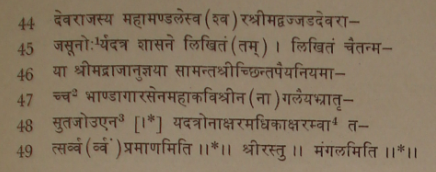|
The Indian Analyst
|
North Indian Inscriptions |
INSCRIPTIONS OF THE SILAHARAS OF NORTH KONKAN
TRANSLATION (For the translation of verses 1 to 3, see that of verses 1, 2 and 4 respectively in the Ṭhāṇā plates of Arikēsarin, No. 8, above). In his family- ..(V. 4). There was first the illustrious Kapardin (I), then Pulaśati (i.e. Pullaśakti), (then) his son, another Kapardin (i.e. Kapardin II); (then ) his son Vappuvanna became king; thereafter there was Jhañjharāja. (Thereafter there ruled ) his brother Gõggirāja and after him (there was ) king Vajjaḍāchāryadēva. From him was born the son (Aparājita ), who was the veritable Sun-god in brilliance, an ornamental mark of the three worlds. .. (V. 5). There was an illustrious (king) named Vajjada (II); thereafter there was the king, the illustrious Kēśidēva. Then his nephew and son of Vajjaḍadēva, the illustrious Chhintapaiya became king.
.. (Line 13). Now, the illustrious king Chittapaiyadēva,− who has, by his religious merit, obtained the right to five mahāśabdas, and who is adorned with all royal titles such as Mahāsāmantādhipati , ‘the lord of the City of Tagara’, (he) who has excelled the world in charity’, ‘an adamantine cage (for the protection of ) those who seek refuge with him,’ and so forth,−addresses, with salutation, worship and respect, all his followers, principal as well as subordinate, assembled (here), whether connected with him or not, as follows :− .. âBe it know to you. One should accumulate the reward of charitable gifts by very firm non-attachment, having realised that this worldly existence is worthless and that wealth as well as life are extremely fickle like drops of water on the leaf of a lotus-plant tossed by wind.â
..
(Line 20). Having thought over the following saying of the sages, viz. in the Kṛita, Trētā
and Dvāpara Ages penance is highly praised; the sages extol only charity in the Kali Age, I−
having bathed at an excellent tīrtha on the holy occasion of the Udagayana which occurred
on Monday the eleventh tithi of the dark fortnight of Pushya (Pausha) in the (cyclic)
year Prabhava after nine hundred years increased by forty-nine have passed by the era
of the Śaka king,−in figures, the year 949, (the month) Pushya (Pausha), the dark fortnight, the (lunar) day 11 – and having worshipped the Divine lord of Umā (Śiva)− have
donated, with the pouring out of water, the revenue amount of twenty drammas, free
from all dues, on the cluster of tress in the orchard donated by the Daṇḍanāyaka, the illustrious
Nāgavarman, situated in (the village of ) Velāsivāgara, comprised in the vishaya of Mandaraja, to the learned Brāhmaṇa Gōvinda, the son of Saudapaiya of Tīpaka, who belongs to
the Kāśyapa gōtra and Ṛigvēda śākhā, who is residing at Dīpakāgara and is (always ) engaged
in the performance of this six religious duties.
[1] Read सूनोर्यदत्र.
|
|||||||||||||||||||||||||||||||||||||||||||||||||||||||||||||||||||||||||||||||||||||||||||||||||||||||||||||||||||||
| > |
|
>
|








